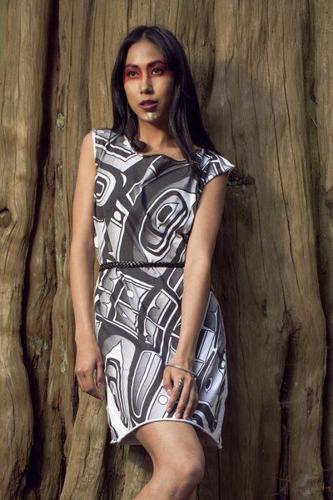The items in museums are usually hanging on walls or mounted on pedestals.
But in “Native Fashion Now,” a new exhibit of Native American fashion designs at the Peabody Essex Museum in Salem, the “Cascading Parasols” in the first gallery are floating in the air.
They were designed by Patricia Michaels, and their canopies and handles look like petals and stalks, suggesting Michaels’ Native American name: Waterlily.
“There is one named ‘Waterlily’ and seven shaped like water lilies in the show,” said Michaels, a member of the Taos Pueblo tribe who lives in Santa Fe, New Mexico. “I thought of organic things that do rise above murky water.”
But her parasols also have a spiritual dimension and carry messages.
“They’re prayers for everyone to have success in whatever they’re trying to achieve,” Michaels said.
She instructs models carrying her parasols that they should think of themselves as female souls.
These associations came together in a creative process that connects Michaels, who appeared on season 11 of “Project Runway,” with her Native American family and traditions.
“There’s new thoughts, just as my grandmothers and grandfathers had new thoughts as they thought about how America was changing around them,” she said.
Michaels is one of 74 Native American fashion designers whose dresses, shoes and jewelry are on display in the exhibit, the first to feature designs solely by Native Americans.
In addition to her parasols, a “Cityscape Dress” that Michaels designed for “Project Runway” also appears in the show.
She said the design was inspired by a boat trip that the contestants took around Manhattan and also draws from paintings by Georgia O’Keeffe and Agnes Martin, artists who spent time in both New Mexico and New York.
“I thought, I’ll take Georgia’s window from one of these paintings and take Agnes Martin’s minimalism and make a grid — make it a little bit abstract,” Michaels said. “Then I just made it into a shift dress.”
Each of the works in “Native Fashion Now” expresses a unique sense of style, while also referencing larger issues in contemporary and Native American culture.
“One tradition never changes in Native American art: Things change,” said Karen Kramer, curator of Native American art and culture at the Peabody Essex Museum.
Many of the works in the exhibit feature motifs, designs and color combinations that evoke tribal traditions. But they are also likely to be made from space-age materials and to appeal to a wide range of tastes.
Kramer describes the work in the show as “funky, relevant and a little bit sexy” and said it “challenges stereotypes” by showing that “there are countless ways of being Native in this world.”
There are dresses from the 1950s and ’60s by Lloyd “Kiva” New, a Cherokee whose work was sold in high-fashion stores across the country and who is considered the father of contemporary Native American fashion design, Kramer said.
There is also a brocade gown of bold red that was worn by first lady Betty Ford and was designed in 1974 by Frankie Welch, a Cherokee who ran a boutique in Alexandria, Virginia.
Street style is represented by skateboards and sneakers with Native American-inspired designs. There are also T-shirts with activist slogans, such as one proclaiming “Native Americans Discovered Columbus” by Jared Yazzie, a Dine, or Navajo.
There is an elegant Eagle Gala dress by Dorothy Grant, a designer from the Haida people of the Pacific Northwest, which sets traditional images of eagles in motion with flowing folds of silk.
There is also a dress by American fashion designer Isaac Mizrahi that looks like a totem pole, an important element of Haida culture.
Mizrahi’s dress is included as an example of borrowing and exchange between mainstream and Native American cultures, while leaving it to the viewer to decide whether he is paying homage to Native American tradition, or exploiting it.
If you go
What: “Native Fashion Now”
When: Through March 6. Open Tuesdays through Sundays, 10 a.m. to 5 p.m., and on the third Thursday of every month from 10 a.m. to 9 p.m. Closed Mondays (except holidays), Christmas and New Year’s Day.
Where: Peabody Essex Museum, 161 Essex St., Salem
How much: Admission is $18 for adults, $15 for seniors, $10 for students, and free for youths 16 and under.
More information: 866-745-1876 or www.pem.org




















Commented
Sorry, there are no recent results for popular commented articles.